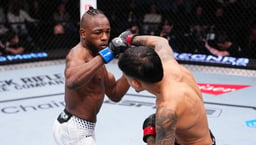
Issue 146
Kicking back is just as important as kicking in. Here’s the lowdown on the perfect way to take a load off.
AS THE CLOCK TICKS, REST LESS
The amount of training top MMA fighters put in every day depends on whether or not they are ‘in-camp,’ where they’ll be training for a bout on a set date. “Most camps typically last about eight to twelve weeks,” says Nathan Brodnax, an agent to fighters including Martin Kampmann and Chris Lytle.
“This can vary but most fighters spend three to five hours a day training, five days a week when they’re not in-camp. And four to six hours a day training, six days a week when they are in-camp. This is divided into one or two hour periods throughout the day.”
For example, former WEC lightweight champion ‘Razor’ Rob McCullough will normally break up his training routine into one or two hour blocks, doing two hours of grappling in the morning, two hours of stand-up in the afternoon and 90 minutes of strength and conditioning in the evening. He made the right decision to quit his day job because there wouldn’t be time for anything else.
FILL DOWN-TIME CONSTRUCTIVELY
When ‘in-camp’ it’s no secret that some of the world’s top brawlers seclude themselves to KO distractions. Brock Lesnar famously trains in the mountains and on occasions so does Randy Couture.
“This is why many Southern California fighters like to do their training camp in the Big Bear Mountains,” explains Brodnax. It’s not just about the altitude benefits because the self-imposed isolation that helps fighters stay focused. This does of course vary from fighter to fighter. “UFC welterweight Mike Pierce likes to relax in front of his computer and play games between practice sessions, Rob McCullough spends time with his son and UFC 170lb’er Anthony Johnson likes to hang out with his pit bulls.”
Everyone is different, but the ability to decompress quickly so that you have the mental and physical energy to get back in the gym for more intense training is a big part of having a successful camp.
ACTIVE REST IS ESSENTIAL
Rest doesn’t have to mean denting the couch. You can keep moving without actually training: in fact, this strategy will bolster your recovery. Doing light exercise not only improves your rate of recovery from competitive exercise but also keeps an athlete’s minds fresh after a strenuous bout or match, found new research in the British Journal of Sports Medicine. “It forces healing blood into all the muscles which speeds up recovery,” says MMA coach Brendan Chaplin.
But if you do it, remember to keep the intensity low. “Many of my clients follow active rest by taking a slow walk, cycling or swimming,” says Brodnax. It doesn’t have to take too long so won’t let you get behind in your TUF viewing.
BALANCE MEDIA AND TRAINING
Media appearances are a very important because no matter how good of a fighter you are, if no one knows who you are, they won’t pay to watch you fight. “When appearances are piled on top of a fighter’s already packed schedule, they can be taxing,” says Brodnax.
Some fighters enjoy them while others find they shift their focus. The trick is to work it into the training schedule so it doesn’t affect exercise times.”
REST BEGINS IN BED
The most valuable rest period is when your head slams the pillow. “‘Razor’ Rob McCullough always gets eight hours, or more, sleep a night and tries to nap between training to recharge.” But too little sleep is as damaging as too much. Four to six hours will reduce your stamina and endurance by 15-40% found research in the European Journal of Applied Physiology and Occupational Physiology.
Too much – over 12 hours a night – can make you 25-35% more likely to be obese, found a study in the Journal of Sleep. So it seems getting 8-10 hours is ideal – it accelerates the release of your recovery hormones, improves reflexes and boosts sprint times by up to 8% (found research at Stanford University). Next time you’re enticed by Letterman remind yourself that your performance in cage could really be down to sleeping right.
...









